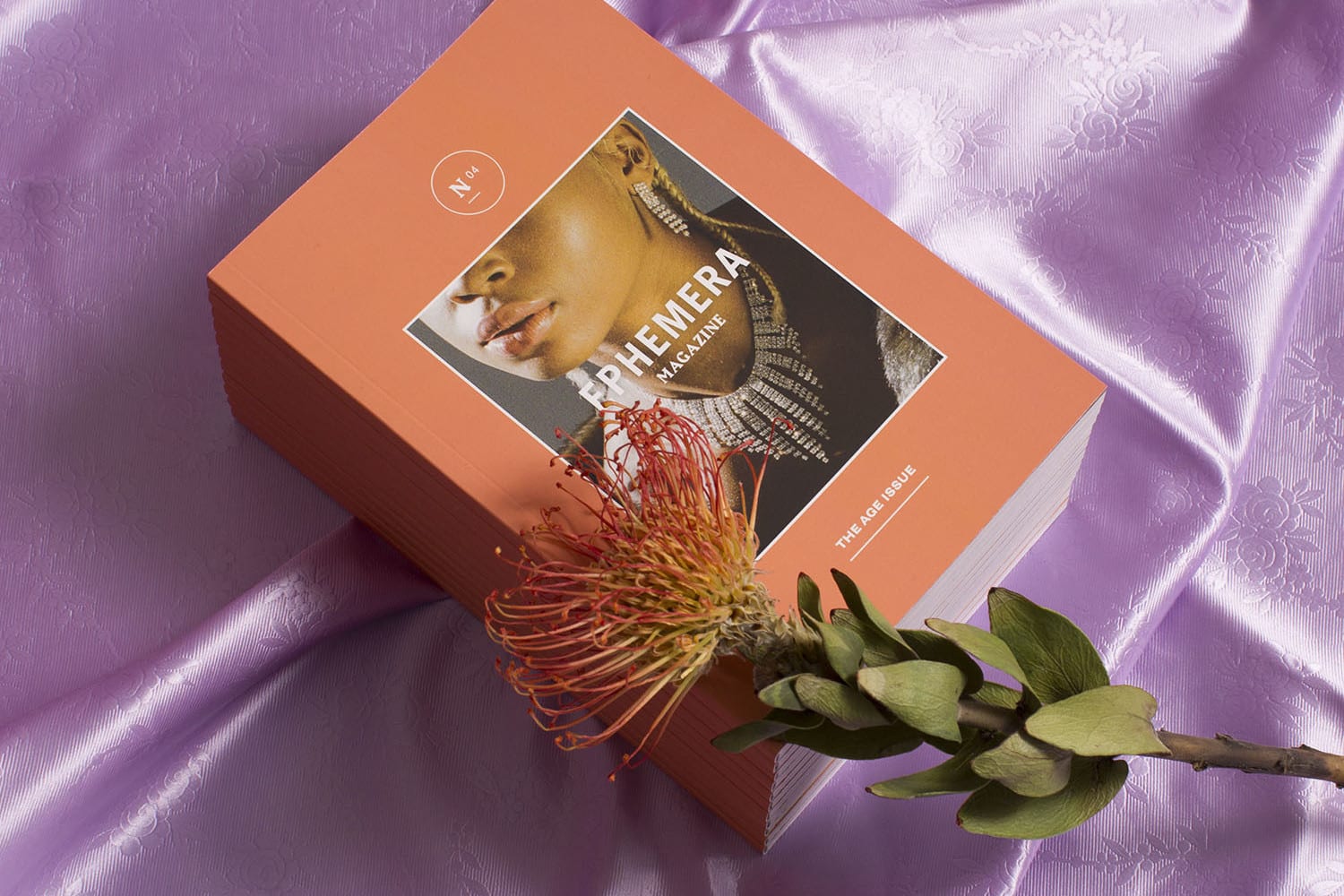Andy Warhol’s Revista Interview recently announced its closing. The Village Voice has gone totally digital. The bastions of print feel frighteningly close to dwindling. But if you go into your local art bookstore, you’ll likely find new local print titles cropping up all the time. Actually, you don’t even need to leave your house—you’re just as likely to come across print publishing on Instagram, or at least the promise of it, with so many online mood boards and photo feeds teasing “Print edition coming soon” in their bios. As more and more major print institutions shutter, small, limited edition, and often hyper-local magazines are stepping up to take their place.
Ephemera Magazine is one of those titles. Created in Toronto and spearheaded by Maegan Fidelino, Ephemera is creative agency Kastor and Pollux’s answer to short run print magazines. Ephemera Magazine in many ways looks and functions like an independent magazine, but is funded and supported by Kastor and Pollux. It operates in a space between completely independent print and branding agencies, speaking to our current era of multi-hyphenated identities: the personal and the corporate blending into something productive, thanks to the internet.
The actual physical magazine is small, soft to the touch, with velvety paper, and has so far four issues to its name. Each issue is centered around a theme: the first Pop Music, then Travel, Food and most recently, Age. Each issue has featured a range of mostly emerging and mostly Canadian contributors. Fidelino sees Ephemera as offering an accessible entry point into publication for talented creators who may not necessarily have the CVs or connections to get their work into more established outlets.
Fidelino is primarily a graphic designer who’s taken up the task of curating and editing the publication. We contacted her to ask about the benefits of print in a digital age, and why she thinks projects like Ephemera can help amplify emerging voices.
Format Magazine: Your tagline is where I’d like to start: You describe Ephemera as “a print magazine exploring permanence in a world of rapid change.” How does the idea of permanence factor into the magazine? What kind of permanence is being explored?
Maegan Fidelino: Generally speaking, the entire magazine explores ephemeral ideas or objects, or things people categorize as ephemeral but hold more resonance in people’s minds. It’s ironic too, because a print magazine is in many ways obviously an ephemeral object. It’s something that’s becoming extinct these days.
Right, it’s a permanent object, but not necessarily a permanent business model. How does that state of permanence and anti-permanence situate your position as the editor of a print magazine?
For me, it’s really important to give people a platform to get published in print because there are so many that are disappearing, and many of the ones left are owned by institutions, so it’s hard to get your foot in the door. I want Ephemera to be a launching point for people.
Ephemera is a project of Kastor and Pollux, funded by the creative agency. How does Ephemera, which looks from the outside to function like an independent magazine, work as a part of a larger company?
I’ve been really lucky. Dani Roche, who’s the founder of Kastor and Pollux, is a good friend of mine. I told her about the idea two years ago. She told me to pitch it to her and I did. She was at a point in the business model where she wanted to expand to other branches and have her hands in different places, not just be classified as a digital agency.
She wanted to reach more people, and the magazine is a good platform for that. You’re able to reach out to creative people and really explore their work and create a more community-based project. For me as an editor, I’m really lucky in that I have free reign.

The Age issue shot by Dani Reynolds.
What purpose does the magazine serve to Kastor and Pollux?
You could classify it as a not-for-profit passion project.
Do you see it as a duty of companies or agencies like that to be supporting art directly?
I don’t think it’s mandatory, but I think it’s culturally important to create work that resonates with people and isn’t just for ad money.
What do you see as the role of a magazine like this in the current cultural landscape?
It’s hard to say. I don’t know where this will be in two, three, five years because this is a model that in some ways doesn’t exist anymore. It’s hard to get government funding even. It’s gaining momentum, and each issue there are more people interested. Having people who want to share their stories and share their images, engage with the content—that’s the most important part for me.
You just released your fourth issue. Your format for the magazines are all cohesive, but do you see growth between each issue? Do you have a vision for where you see the magazine going?
I don’t think I’m looking long-game that far, just because it’s an ever-changing industry. I’d love to get a distributor to be able to reach bigger audiences.
There’s always going to be a conflict between art and commerce and trying to find a balance between the two.
You were saying that Ephemera is also a tool for reaching bigger audiences for Kastor and Pollux. What are your thoughts on using art and magazines as a tool for branding?
As long as you’re careful about it and not trying to be manipulative, I think it’s a good way for brands to communicate with culture around them.
Speaking more largely here about branding agencies, do you feel there’s conflict between creating art that is funded by a company, or attached to a company?
There’s always going to be a conflict between art and commerce and trying to find a balance between the two. You have to take corporate projects to fund your art a lot of the time.

Spread from the Age issue.
How do you see social media relating to print? There’s a strange sort of paradox where print seems in a lot of ways like the antithesis of social media, and yet I found Ephemera through Instagram. How do you unite those two mediums?
You have to accept that they go together. Yes it’s a print magazine that exists offline, but almost everybody finds it online. It has to be friendly to an audience that consumes content online. One of the challenges in creating a new magazine is making the content engaging in a way that people will actually read pages of just words, but I also need to design it in a way where people will not get bored.
You’ve featured so many amazing Toronto-based and Canadian artists. How do you go about finding contributors?
Every issue, before we start the issue I send out a pitch package that’s promoted by Kastor and Pollux, and I send it to a few people whose work I really enjoy and would love to have in the magazine. Then other people pitch me their ideas and I curate it, edit down their work.
What would be included in a pitch package?
For our most recent issue, Age, there was a general idea on how Age relates to Ephemera and what I thought about that. Then I gave ideas on how people could engage with that. For example, the glorification of youth. I took that as having a negative connotation, but a lot of people took it as a positive, which is interesting when people react in a different way than anticipated.
How do you find a thread of cohesion for an issue?
Once all the submissions are in, I look at the main themes people are exploring and make sure there’s not too much of one thing, and look at what threads I can pull at. With photography people will put together a series and from there I look at what I want to be the photo feature. I look at what illustrations can stand alone and which have a lot of promise but don’t necessarily have an idea that connects well enough, so I’ll bring them on create something for a written piece.
A lot of market magazines are big corporate entities so they want people to have already proven themselves. I love the pieces from writers who have never written anywhere before.
A lot of the contributors are Toronto-based. Is the idea of being local important to you?
That happened organically since Kastor and Pollux is Toronto-based. But it’s grown—we’re stocked at Skylight Books in LA because a contributor lives there; I had somebody Instagram DM me asking if they could be a part of the magazine and they’re in this one. It’s amazing!
How do you go about getting places to stock the magazine without a distributor?
It’s a lot of cold emailing; asking contributors if they know places in their cities we should reach out to. It’s still something I’m working on building more, but the growth is happening. Two issues ago was really hard for me because I wanted things to happen right away. But things are finally progressing and going in a good direction.

Maegan Fidelino shot by Brandi Shields-McGee.
What do you feel like your vision for Ephemera is that separates it from other magazines that exist?
I really try to engage new talent. A lot of market magazines are big corporate entities so they want people to have already proven themselves. I love the pieces from writers who have never written anywhere before. They’re such fresh voices, images, ways of looking at things. Because the topic of the magazine changes continually it engages different people each time.
On a technical note, how do you go about creating a magazine like this? What are the logistics that go into it?
Like I said, I first pitched it to Dani Roche. After that it was a lot of spreadsheets to figure out if it would ever be profitable. We printed the first issue on a very small budget, only 100 copies, and we’re all sold through which is nice. For the second issue Dani was able to get Fido on as a sponsor, which gave us a bigger budget. We printed 500 copies, which was way too many. It’s hard to get the copies out to enough stockists.
What is the design process like of the magazine and how long does that usually take?
We sent out the pitch package for this issue in January, got pitches in late January; people started working on their first drafts, and when people started sending them I’d lay them out in a way that’s very sparse. I’d continually design as I got updates. It’s mostly a one-woman project, so I design the whole issue.
Do you have any advice for people who might be wanting to start their own publication?
If you want to start a project, do it as cheaply as you can and tell all your friends about it. DM anyone for help. People want to support other creative people.
Header image shot by Dani Reynolds.
More on print and publishing:
Cómo escribir una presentación que te haga publicar
Refinery29 Creative Director Piera Gelardi is Keeping It Messy
Bad Day Magazine’s Jackie Linton Works in Print














